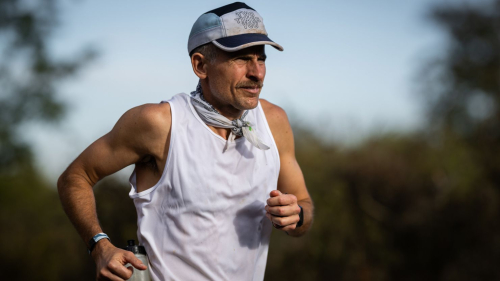 Harvey Lewis ran 450 miles during Big’s Backyard Ultra, the world championships of backyard ultra running held in Bell Buckle, Tennessee. Howie Stern CNN —
Harvey Lewis ran 450 miles during Big’s Backyard Ultra, the world championships of backyard ultra running held in Bell Buckle, Tennessee. Howie Stern CNN —
There came a moment, somewhere on a roadside in rural Tennessee, when Harvey Lewis felt like he could keep running forever.
At this point, he had already been on the move, practically non-stop, for about four days, looping around the same roads, trails, and tracks amongst an ever-shrinking group of runners.
He was battling through feverish sleep deprivation on leaden, depleted legs, and on the front of his sweat-stained vest he wore the splattered evidence of an earlier nosebleed.
But looks can be deceiving, and deep in the corner of his stubborn mind, Lewis knew that he held the golden ticket to winning this backyard ultramarathon race: ensure that every other competitor quits before you.
As the race wore on, he began to feel unstoppable.
“It was like a frequency I found with my rhythm and my pace,” says Lewis, “where I could just maintain that for an incredible amount of time.
“There was some sort of place where my brain took over … and the body finally surrendered to my mind.”
 US ultramarathon runner Courtney Dauwalter poses during her morning fitness run near Twin Lakes, Colorado, on May 16, 2023. Dauwalter sits at the apex of an elite group of ultra runners — people who run 50, 100 or 200 miles (322 kilometers) in one go. Wearing over-sized shorts and a huge smile, she burst onto the scene around a decade ago, and was soon leaving competitors — including men — for dust, knocking hours off course records. (Photo by CHANDAN KHANNA / AFP) (Photo by CHANDAN KHANNA/AFP via Getty Images) Chandan Khanna/AFP/Getty Images
US ultramarathon runner Courtney Dauwalter poses during her morning fitness run near Twin Lakes, Colorado, on May 16, 2023. Dauwalter sits at the apex of an elite group of ultra runners — people who run 50, 100 or 200 miles (322 kilometers) in one go. Wearing over-sized shorts and a huge smile, she burst onto the scene around a decade ago, and was soon leaving competitors — including men — for dust, knocking hours off course records. (Photo by CHANDAN KHANNA / AFP) (Photo by CHANDAN KHANNA/AFP via Getty Images) Chandan Khanna/AFP/Getty Images
This was at Big’s Backyard Ultra in October, the world championships of backyard ultrarunning.
The discipline of ultrarunning is broadly defined as any distance beyond the 26.2 miles of a marathon, but a backyard ultra has no predetermined length. Runners complete a 4.167-mile loop on the hour, every hour until only one person is left standing. The other competitors are deemed not to have finished, either by dropping out or failing to complete a loop within the cut-off time.
Lewis, a high school teacher and seasoned distance runner from Cincinnati, entered uncharted territory as far as backyard ultras are concerned, completing a scarcely believable 108 loops – the equivalent of 450 miles – over four and a half days at Big’s.
His gargantuan feat of endurance and resilience eventually came to an end when his final competitor, Ihor Verys, failed to complete his 108th loop, becoming what’s known in backyard ultrarunning as “the assist.”
Several weeks later, Lewis is still trying to get his head around his world record – six laps, or 25 miles, more than Australian Phil Gore’s managed at a backyard ultra earlier this year.
“I managed to pull off stretching it to four and a half days,” Lewis tells CNN Sport. “That’s really kind of riveting to me. It sparks my imagination.”
In total, Lewis covered the equivalent of the entire length of Florida, or about the distance from his hometown Cincinnati to Atlanta, stopping only for a few minutes between each loop.
He was midway through his final loop when it suddenly dawned on him that Verys had finally succumbed to the race’s gauntlet of pain, handing Lewis the victory as long as he could haul himself to the cut-off one last time.
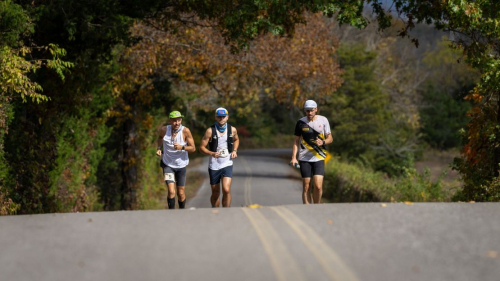 Lewis (left), Canada’s Ihor Verys (center), and Poland’s Bartosz Fudali were the last three runners standing at Big’s Backyard Ultra. Howie Stern
Lewis (left), Canada’s Ihor Verys (center), and Poland’s Bartosz Fudali were the last three runners standing at Big’s Backyard Ultra. Howie Stern
“Finishing the final person, you’re on cloud nine,” the 47-year-old Lewis says. “It’s like one of the biggest highs of my life. I couldn’t describe it, especially when it’s such a rigorous, challenging goal.”
There are hundreds of backyard ultras staged around the world each year, but Big’s is the discipline’s original and most famous event.
The concept was devised by Gary Cantrell, the gatekeeper of some of the world’s most punishing foot races, including the fabled Barkley Marathons. Better known as Lazarus Lake, or simply “Laz” to those in the ultrarunning community, Cantrell first staged Big’s around his farm in Bell Buckle in 2011.
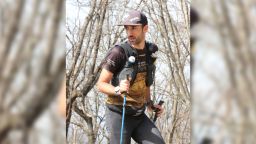 Aurélien Sanchez was one of three finishers at this year’s Barkley Marathons Alexandre Ricaud
Aurélien Sanchez was one of three finishers at this year’s Barkley Marathons Alexandre Ricaud
The race consists of two different loops: one on trails during the day and another on roads during the night. The start and end of each loop is marked by an overhead structure which reads “there is no finish,” the first three words written by hand and pinned to the banner in crude fashion.
It is there that runners must congregate at the top of the hour, every hour in order to stay in the race.
“It’s a tribute to a human’s ability to just continually push that boundary of what’s possible further and further out,” Cantrell says in a video promoting the event.
Lewis, now a two-time winner and three-time assist, is a dedicated disciple of Big’s. He credits success in this year’s race to a combination of careful preparation, his previous experience on the course and at many other ultramarathons, and sheer force of will in the closing stages.
“I always believed that I was going to still be the final person, and I never lost the vision of that,” says Lewis.
His training for this year’s race was at times peculiar, especially when it came to managing sleep deprivation. During his lunchtime breaks at school, Lewis would roll out a yoga mat in a storage closet and try to fall asleep for three to five minutes as quickly as possible, simulating the short breaks he would get between loops at Big’s.
Other times, he says that he would run to the park and lie down on the grass for several minutes.
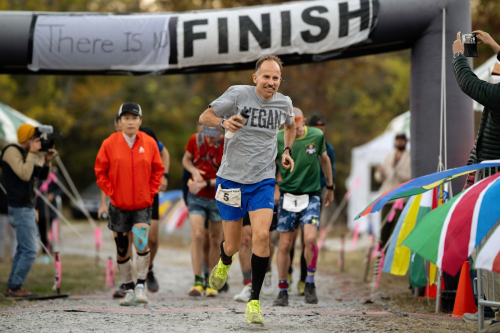 Lewis sets off for another lap at Big’s Backyard Ultra in Bell Buckle, Tennessee. Howie Stern
Lewis sets off for another lap at Big’s Backyard Ultra in Bell Buckle, Tennessee. Howie Stern
Come the race itself, Lewis’ sleep strategy hardly went to plan. Unable to quiet his mind the night before, he only slept for three hours and then didn’t sleep at all for the first three days of the race. After that, he was able to switch off for one or two minutes between loops.
Thankfully, he wasn’t derailed by the same “incredibly intense hallucinations” that plagued him during a backyard ultra in Australia earlier in the year.
“I actually saw these grass people and the trees came alive,” Lewis recalls. “I would fall asleep for just a second, my sense of sound was super accented. It was like that show ‘Stranger Things.’”
His strategy if he gets similar hallucinations in another race? “I feel like I would be able to, like, just run through that,” Lewis adds. “It would maybe make it very interesting.”
That’s not to say that his sanity remained entirely intact at Big’s: on the fourth day, he started to talk gibberish to the other competitors.
“I was semi-conscious, semi-dreaming, and I would just start to say random things,” says Lewis. “I had to censor myself and not just say whatever I was thinking in my dreamlike running state.”
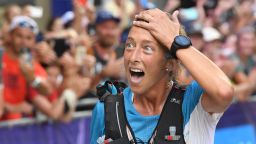 USA’s Courtney Dauwalter reacts after winning the 170 km Mount Blanc Ultra Trail (UTMB) race around the Mont-Blanc crossing France, Italy and Swiss, on August 31, 2019 at the end of the race near Chamonix. (Photo by JEAN-PIERRE CLATOT / AFP) (Photo credit should read JEAN-PIERRE CLATOT/AFP via Getty Images) Jean-Pierre Clatot/AFP/Getty Images
USA’s Courtney Dauwalter reacts after winning the 170 km Mount Blanc Ultra Trail (UTMB) race around the Mont-Blanc crossing France, Italy and Swiss, on August 31, 2019 at the end of the race near Chamonix. (Photo by JEAN-PIERRE CLATOT / AFP) (Photo credit should read JEAN-PIERRE CLATOT/AFP via Getty Images) Jean-Pierre Clatot/AFP/Getty Images
He estimates that he consumed more than 40,000 calories during the race, all of which was plant-based – something Lewis says helped to settle his stomach when eating on the move.
His race diet was varied and plentiful: avocado and hummus wraps, lentil soup, peanut noodles, vegan mac and cheese, vegan yoghurt, cupcakes, and different fruits – blueberries, mangoes, watermelon – were all on the menu.
He also never drank water on the course, instead opting for fluids with calories like coconut water, Coke, or electrolyte drinks.
“I was always grazing on foods,” says Lewis, “enjoying my appetite and enjoying the smorgasbord.”
An upset stomach is one of myriad challenges a runner might face at Big’s. Another is the risk of a fall – particularly on the roots, rocks, and foliage found on the day-time loop around Cantrell’s farm – while rattlesnakes and copperheads can also make for alarming bystanders on the trails.
Lewis fell just once, evidenced by the reddish marks that appeared on the side of his head towards the end of the race. “I’m pretty good at falling,” he explains. “I’ve fallen a lot in my lifetime.”
How a runner responds to adversity can be crucial at determining how long they survive at Big’s. Lewis figures that the effort required in the race is about 70% mental and 30% physical, and he has developed unique ways of hardening his mind during backyard ultras.
“I have spirit animals that I like to embody in the race,” says Lewis. “With Big’s, I was saying that my spirit animal was the honey badger. The honey badger can be knocked down, beaten, bitten, cut – everything happening to it and the honey badger just keeps on going.”
The honey badger analogy can also be extended to Lewis’ ultrarunning career as a whole, his progress in the sport gutsy and gradual. He says that he achieved the qualification time for the Boston Marathon after 17 years of trying and won an ultramarathon 13 years after competing in his first.
He describes himself as a “chubby” kid growing up – quite the contrast to the man who these days runs to and from work, adding extra distance as he builds up to a race.
“It was an ultra to get to where I am today,” says Lewis.
He was running Big’s to raise money for the Brighton Center, an organization in Northern Kentucky which helps individuals and families to achieve financial stability and independence, and also wants to inspire people to invest more in their personal health – even if that means getting outdoors for 20 or 30 minutes each day.
And in terms of his personal goals, Lewis has started to reflect on what it might be possible to achieve in the backyard ultra format.
“If the opportunity comes again: how will I be able to go through that fifth night?” he muses. “How will I come out on that sixth day, and then will we get back to another night?”
Four and a half days and 450 miles might just be the start for Harvey Lewis. This is, after all, a race with no finish line.
